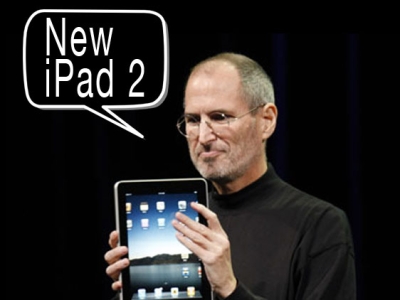Why Apple Can Produce Tablets for Less Money
IHS released a report that describes some of the reasons why Apple has critical advantages in designing the iPad and why it may be able to keep those advantages in the foreseeable time.
The market research firm believes that Apple's control over the entire platform, especially the software provides it with a unique opportunity to design tailored hardware that deliver cost and integration scenarios its rivals cannot achieve.
“Apple takes a vertically integrated approach to its products, from the operating system to the user interface, to the hardware design, down to the selection of individual parts used in the device,” said Wayne Lam, senior analyst, competitive analysis, at IHS. “For example, Apple even uses its own applications processor design in both the iPad and iPad 2. In contrast, Android tablet makers buy those capabilities from the likes of Nvidia, Texas Instruments and Qualcomm. This gives Apple greater control in multiple areas of product development.”
For example, IHS said that Apple's ability to control the OS enables the company to reduce cost by limiting the quantity of memory in the iPad. The current-generation iPad 2 uses 512 MB SDRAM, while its rivals use 1 GB. "This memory density reduction results in a nearly $14 reduction in the bill of materials of the iPad 2 compared to other tablets, the market research firm noted.
“Since Apple controls both the operating system and hardware design of the iPad, it is able to attain design efficiencies that other tablet manufacturers cannot,” Lam said. “These efficiencies become obvious in areas like the memory and the battery, where Apple maintains advantages in cost, space savings and performance compared with every competitor in the business.”
Get Tom's Hardware's best news and in-depth reviews, straight to your inbox.

Douglas Perry was a freelance writer for Tom's Hardware covering semiconductors, storage technology, quantum computing, and processor power delivery. He has authored several books and is currently an editor for The Oregonian/OregonLive.
-
Doesn't surprise me! There's no way around it, but Apple has learned to maximize the use of its hardware for the software they employ. Sure the software could incorporate some features that Android has had for a while, but Android has all these powerful phones and tablets and there are distinct performance flaws regardless of the Hardware specs that trump Apple's offerings.Reply
-
Ragnar-Kon Not a big fan of iPads (or tablets in general for that matter), but you have to admit that Apple is being very smart about this approach in mobile platforms.Reply
It costs them less money to manufacture the equipment, but yet they sell it for the same price (or more) as the competitors. Genius. Sure the specs of their products may be less than the specs of a competitor's, but if it performs just as well, who cares? -
Assmar Not a single mention of Foxconn? They're replacing their employees with robots soon, because robots haven't yet learned how to commit suicide.Reply -
GreaseMonkey_62 We are starting to see more Android tablets that are beating the iPad on price now. Acer and Asus come to mind.Reply -
Haserath assmarNot a single mention of Foxconn? They're replacing their employees with robots soon, because robots haven't yet learned how to commit suicide.Have you even checked the suicide rates of cities the size of the Foxconn factory? I believe there are ~800,000 people working there, which is bigger than the city I live in, and I'm sure there are more suicides here than the ones there. People have real life problems; it might not have anything to do with Foxconn... They did handle the situation poorly though.Reply
Back to tablets: Has anyone compared Apple's ipad 2 to the competition? The chip has the same 1ghz processor as the Galaxy Tab 10.1(uses Tegra 2), but is 2-3 times more powerful in the graphics department. The Galaxy Tab does have 1GB of memory though, which can be useful. But the ipad 2 also has a longer lasting battery, this is really nice for long trips away from a plug. You can check it out.
http://www.anandtech.com/show/4445/samsung-galaxy-tab-101-review/7 -
Belardo Acer and ASUS are the only ones... there are others selling tables for $250 or so, but they are easily cheap garbage with low quality displays, very limited memory.Reply
Like in the old days, there are disadvantages and advantages in typing the software to the hardware. An example, a 1986 Amiga 1000 with 7Mhz CPU and 1MB of memory running AOS2 in 1990, was easily FASTER than a 386 @ 25mhz with 2~4mb of RAM running Windows 3. Why? The OS and software can talk directly to its hardware.
Bad thing: It means add-ons and some customizations were more challenging.
So when it comes to the MS-PC world, it always HAS BEEN BRUTE force to get the performance. It always was and always will be this way. So yeah, my iPad1 still feels faster and more responsive in many ways over a TouchPad and Androids with dual core CPUs.
Apple will continue to make a good profit with its iOS products in ways the Android and others can't (at least for now)... and I'll admit I'm open to going Android for a tablet. WebOS on the HP TouchPad... is very good, there are some areas of weakness as well as the HP brand itself.
People and business refer to these devices are iPads and tablets. Like Coke and other soda... that's good marketing and how it is.
Apple has the hardware and software, but it has direct control over:
- App store
- iTunes for music and movies
- eBooks
Its a different business model than Android and the hardware companies. Asus, Acer, Lenovo, Dell, etc makes money off the sale of the hardware ($30~50 per unit). and that *IS IT*... they are done.
Google makes money off the ads and some off the apps... that's it. That is their business. Not music.
Meanwhile, Apple makes money off the hardware, the apps, the music and the videos. So you can bet, they want to be on top of everything.
I wish Apple will stop the law-suit crap... it makes me NOT want to get an iPad3, but I also don't was a 16:9 tablet. -
azcoyote assmarNot a single mention of Foxconn? They're replacing their employees with robots soon, because robots haven't yet learned how to commit suicide.Reply
Which should result in a huge layoff and then MASS SUICIDES.
Automation is great but there is always a loss of jobs that goes with it.
-
cobra5000 Apple can produce them for less but will they SELL them for less?Reply
We know the answer to that one, already...
